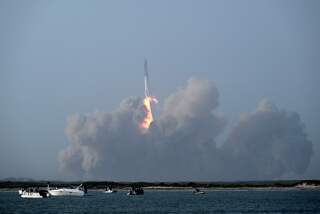Virgin Galactic test flight of space plane moves the company a bit closer to commercial operations
Reporting from Mojave â In a graceful test flight Thursday, Virgin Galacticâs SpaceShipTwo dropped from its carrier aircraft and arced through the air.
After a few minutes of flight, the glinting space plane emptied a 2,500 pound tank of water meant to simulate the weight of a rocket engine. The result left a curving white trail across the desert sky.
It was the latest sign that Virgin Galactic, the space tourism venture backed by billionaire Richard Branson, is rebounding from a fatal 2014 midair test failure, and inching closer to its goal of ferrying tourists on suborbital space flights for $250,000 a pop.
Company executives emphasized they still face a handful of glide tests before Virgin Galactic can resume rocket-powered tests.
âThereâs still work to go, but so far, what we found is the vehicle is displaying good handling qualities,â said George Whitesides, chief executive of Virgin Galactic and Spaceship Co., the manufacturing arm of the company.
The space tourism market has started to heat up. The Jeff Bezos-backed Blue Origin has conducted a number of tests on its New Shepard reusable launch vehicle, which will also hoist paying tourists into suborbital space.
And Elon Muskâs SpaceX, based in Hawthorne, announced in February that the company will take two paying tourists around the moon in late 2018.
Bill Ostrove, aerospace and defense analyst for Forecast International, said Virgin Galacticâs flight tests put the company in a âpretty good place.â
âTheyâre steadily making progress,â Ostrove said. âEvery test is more complex than the last one.â
Namira Salim, who in 2006 was one of the earliest customers to sign up as an astronaut for a Virgin Galactic flight, said she is upbeat about the companyâs test schedule.
âIâm totally fine with the pace,â Salim said. âThey might as well do it right and take the time.â
After unveiling the newest version of its space plane more than a year ago, Virgin Galactic has put it through a variety of tests, starting with âcaptive carryâ flights in which the smaller plane remained mated to the WhiteKnightTwo aircraft for the entire duration.
In December, the company moved on to glide tests, as well as a test last month of SpaceShipTwoâs âfeatherâ system, which helps the space plane safely reenter the atmosphere by folding up its two tail booms.
That test was significant because of the role the feather system played in the 2014 disaster.
After Virgin Galacticâs first SpaceShipTwo broke apart in midair, killing one of two test pilots, the National Transportation Safety Board pointed to a premature deployment of the system by the co-pilot.
The agency placed most of the blame for the accident on the space planeâs builder, Scaled Composites, which is now owned by Northrop Grumman Corp. The space planeâs design should have guarded against human error, the safety board said.
The NTSB also said the Federal Aviation Administration should have noted that Scaled Compositesâ hazard analysis failed to account for human error.
Since then, Virgin Galactic has moved plane-building duties in-house. The second space plane, named VSS Unity, was built by Spaceship Co. Virgin Galactic said it devised a mechanism to prevent the feather system from being opened too early.
Thursdayâs flight, which took off at 9:52 a.m. in Mojave, marks the fifth glide test of the new SpaceShipTwo and its ninth flight overall.
The test began with the liftoff of the larger carrier aircraft, which totes the space plane below its belly. The carrier looks like two planes flying hand-in-hand.
The carrier flew to an altitude of 50,000 feet before releasing the space plane to glide back to Earth on its own.
When operational, SpaceShipTwo will fire its rocket motor and soar to an altitude of more than 62 miles above the Earth. There it will coast to offer passengers several minutes of weightlessness and great views before coming back to Earth.
The VSS Unityâs nine-minute solo flight Thursday allowed the test team to collect data on how the space plane handles weight on its way down. The plane touched down on the runway around 10:50 a.m. to applause from a crowd of employees and their families.
The plane was then pulled by a vehicle to Virgin Galacticâs nearby facility, while the carrier aircraft continued to circle above.
âSeems like everything went nominally,â said Todd Ericson, Virgin Galacticâs vice president of safety and testing.
Last monthâs test showed the feather system is smoother and operates better than before, and that it met all design objectives, Ericson said. He added that the mechanism to prevent premature operation also worked ânominally.â
Virgin Galactic is manufacturing its next two SpaceShipTwo space planes, the first of which should be completed by the end of next year.
These new versions will be lighter than VSS Unity, but company executives said they didnât expect to see any other major changes.
CEO Whitesides would not say when Virgin Galactic could begin commercial operations.
âI usually say, âWhen weâre ready,ââ he said. âWeâre making good progress ⌠weâre not going to rush it.â
Twitter: @smasunaga
More to Read
Inside the business of entertainment
The Wide Shot brings you news, analysis and insights on everything from streaming wars to production â and what it all means for the future.
You may occasionally receive promotional content from the Los Angeles Times.











